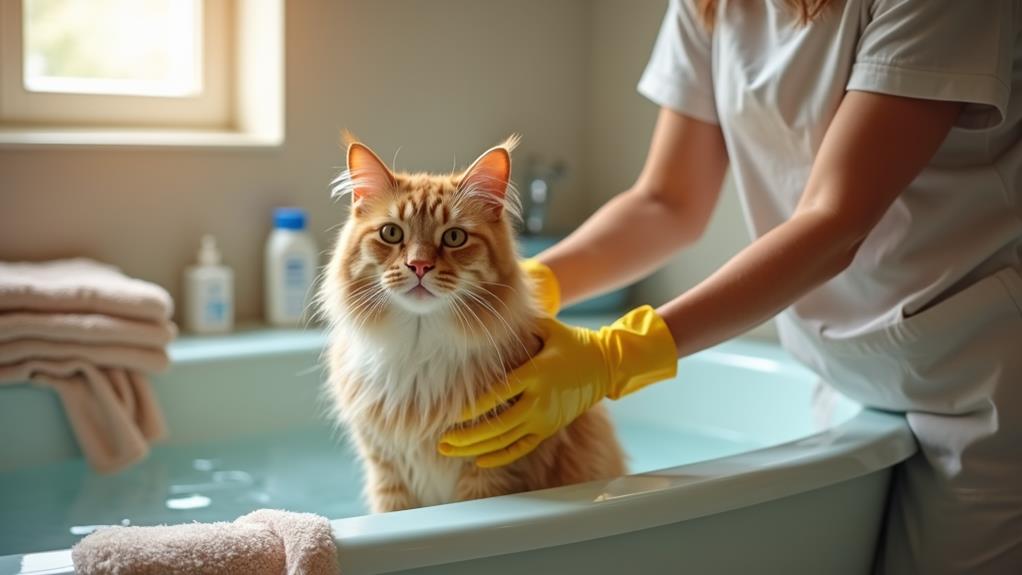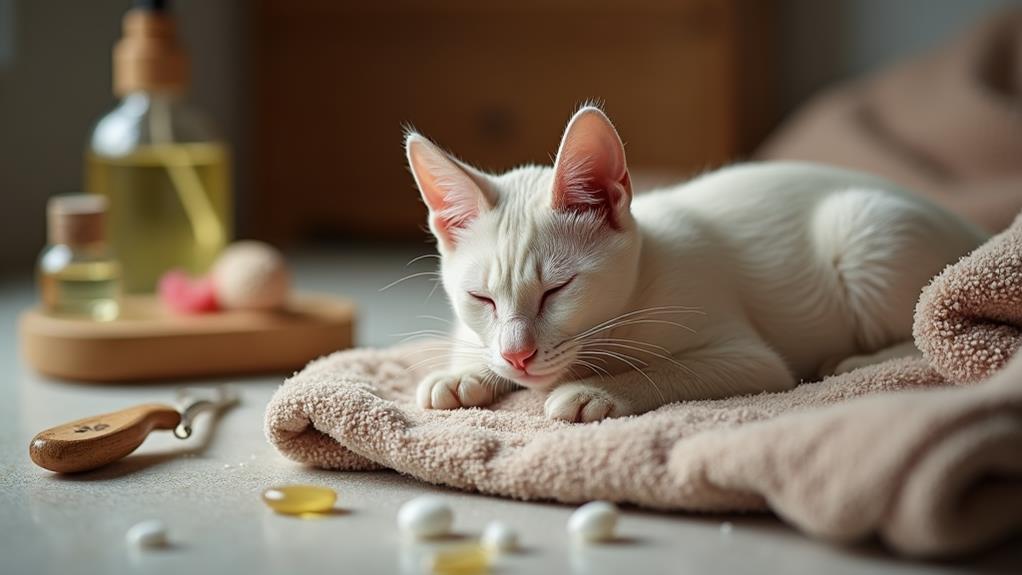How to Clean a Feral Cat: Tips for Handling and Hygiene

To clean a feral cat safely, start by gathering supplies like a humane trap, cat carrier, and cat-specific shampoo. Observe the cat's behavior—flattened ears or crouched posture indicate fear. Use gloves and long sleeves for protection. Choose a quiet space to minimize stress, and handle using calm, gentle movements. For cleaning, use a damp washcloth for the face and lukewarm water with a non-slip mat for baths. Dry the cat with a towel afterward, guaranteeing warmth and comfort. Provide a cozy resting area post-cleaning. These steps help facilitate a smooth process, and there's more to uncover about post-cleaning care.
Understanding Feral Cat Behavior
Understanding feral cat behavior is vital if you're considering how to safely interact with them. Feral cats, unlike their stray counterparts, are typically self-sufficient and prefer to maintain distance from humans. They often form colonies with structured hierarchies, relying on each other more than on people. When interacting, you must be aware of their body language. Signs of fear, such as flattened ears, dilated pupils, and a crouched posture, indicate that a cat is feeling threatened and may react defensively.
Avoidance behaviors are common, with feral cats seeking shelter and hiding during the day to avoid perceived threats. Environmental stressors like loud noises or sudden movements can provoke defensive behaviors, causing a cat to either flee or act aggressively. It's imperative to respect their space and approach slowly, if at all.
Feral cats also exhibit territorial behaviors, marking their territory with scent or vocalizations. They do this to protect their space from other animals and humans. By understanding these behaviors, you can better anticipate their reactions and interact more safely. Always remember, the key to any successful interaction is respecting their boundaries and minimizing stress.
Preparing for Safe Handling
Before you start handling a feral cat, your preparation is vital to ensuring a safe experience for both you and the animal. Start by gathering necessary supplies like a cat carrier, soft towels, and cat-specific shampoo to minimize stress during the cleaning process. If the feral cat is not used to human interaction, using a humane trap is fundamental for safely capturing it, reducing the risk of injury for both you and the cat.
Observe the feral cat's behavior from a distance before attempting any handling. This will help you identify signs of anxiety or aggression and determine the best approach. Look for a quiet space to conduct the handling and cleaning—this calm environment can greatly reduce the cat's stress levels. A warm, tranquil setting is ideal for making the cat feel more secure.
Don't forget to protect yourself while handling the feral cat. Wear protective gloves and long sleeves to prevent scratches or bites, as the cat may react defensively when frightened. With these precautions in place, you'll create a safer environment, reducing anxiety for both you and the animal, and paving the way for an effective cleaning session.
Effective Cleaning Techniques

In relation to cleaning a feral cat, ensuring a gentle approach is essential to minimizing their stress and anxiety. Start by using a damp washcloth to carefully clean around the mouth and eyes. This method avoids aggressive tactics that might scare the cat. If a full bath is necessary, choose a warm, quiet space to set a calm environment. Fill the basin or tub with lukewarm water, which is comfortable for the cat's skin, and place a non-slip mat at the bottom. This mat helps prevent slips and gives the cat a sense of security during the cleaning process.
When selecting a shampoo, opt for a gentle, cat-specific product to avoid skin irritation. Apply it softly, ensuring the cat remains as calm as possible. Once the shampooing is done, rinse thoroughly to remove all residues, as leftover shampoo can cause discomfort. After rinsing, gently towel-dry the cat, keeping them warm and comfortable. This step is vital in maintaining their body temperature and helping them feel secure after the cleaning session. By following these steps, you can effectively clean a feral cat while ensuring they experience minimal stress and maximum comfort.
Managing Stressful Situations
Creating a stress-free environment for a feral cat during cleaning is vital. Start by preparing a quiet space with minimal distractions. This helps the cat feel secure before any cleaning begins. When you approach the cat, use a calm and gentle voice to reassure it. Loud noises can increase its anxiety, so maintaining a soothing tone is significant.
Allow the cat to familiarize itself with the cleaning tools. Gradually introduce these items, letting the cat sniff and inspect them. This reduces fear and stress reactions. When handling the cat, employ soft, slow movements. Sudden actions can startle the cat, leading to defensive behavior and possible injury. Gentle handling helps the cat remain relaxed and more cooperative.
After the cleaning process, provide a cozy resting area. This allows the cat to decompress and recover from the stressful experience. Giving it some time alone in a warm, comfortable spot helps it regain a sense of security. Remember, your efforts to create a calming and controlled environment will make the cleaning process smoother for both you and the feral cat, ensuring its well-being throughout the experience.
Post-Cleaning Care Practices

Once you've successfully created a calming environment for cleaning, focus on the cat's needs afterward to guarantee its comfort and well-being. Providing proper post-cleaning care is vital to help a feral cat recover from the stress of the experience. Here are some key practices to follow:
- Warm, Dry Space for Recovery: After cleaning, it's important to place the cat in a warm, dry space. This will help reduce stress and prevent hypothermia, as feral cats are particularly sensitive to temperature changes.
- Monitor for Distress: Keep an eye on the cat for any signs of discomfort or stress. Monitoring its behavior is significant because stress can lead to health issues or behavioral changes, which could affect future interactions.
- Provide Fresh Water and a Comfortable Resting Area: Make sure there's always fresh water available and a comfortable resting area. This encourages hydration and relaxation, supporting the cat's overall recovery.
- Introduce Food Gradually: It's vital to gradually introduce food in a quiet, secure location. A stressed cat might not eat immediately, so patience is key.
Regular grooming and cleaning sessions will eventually build trust, making future care easier and more effective.




